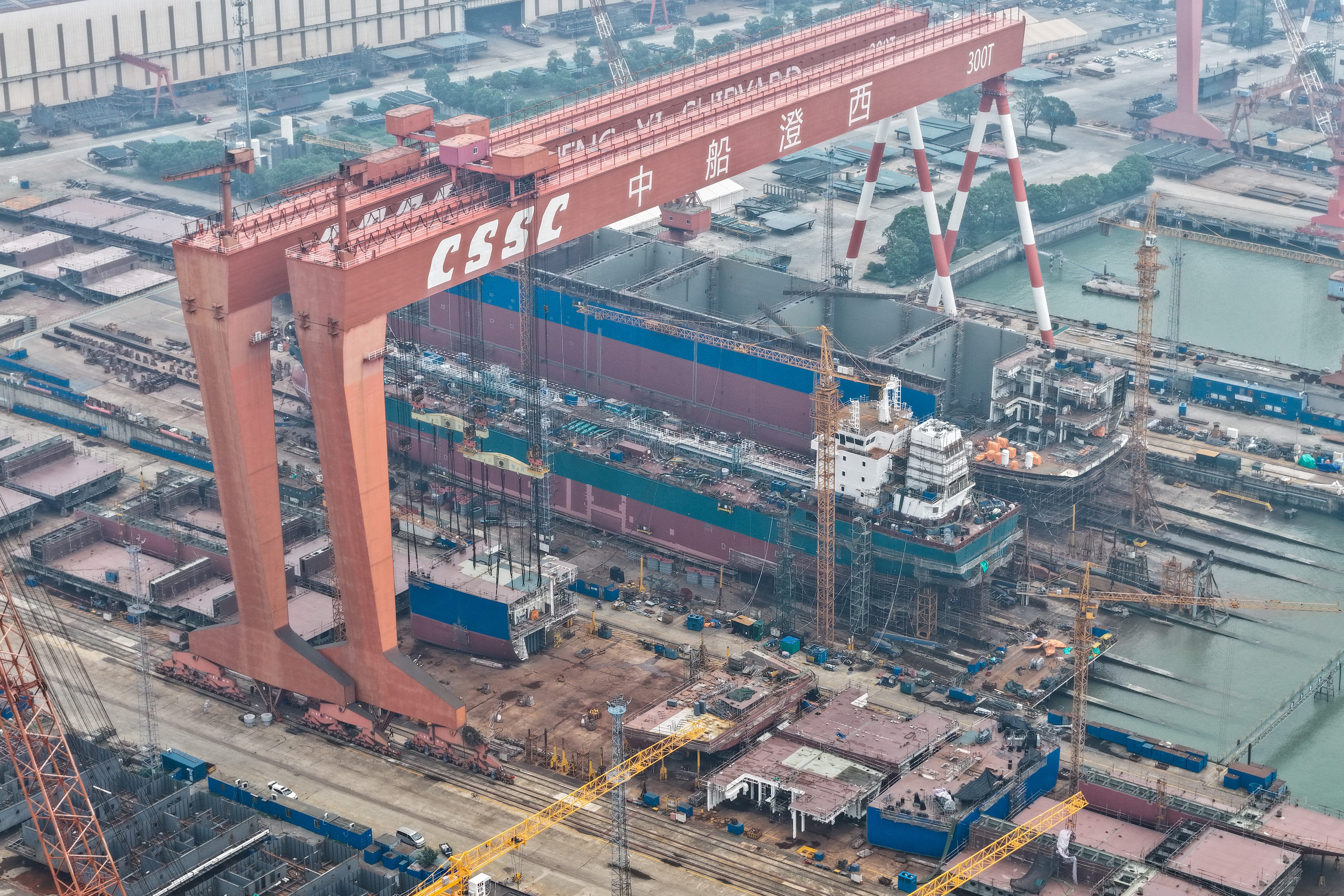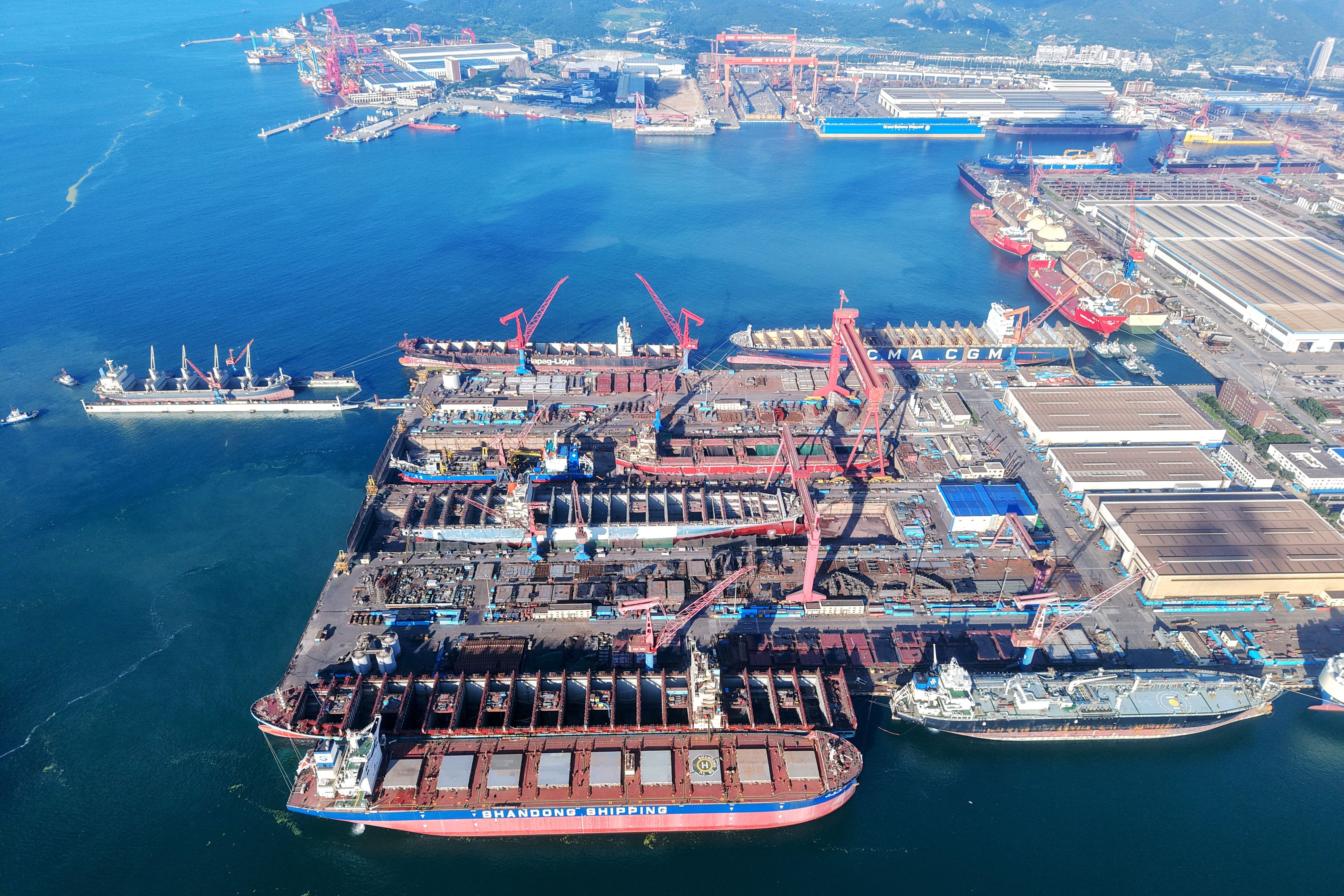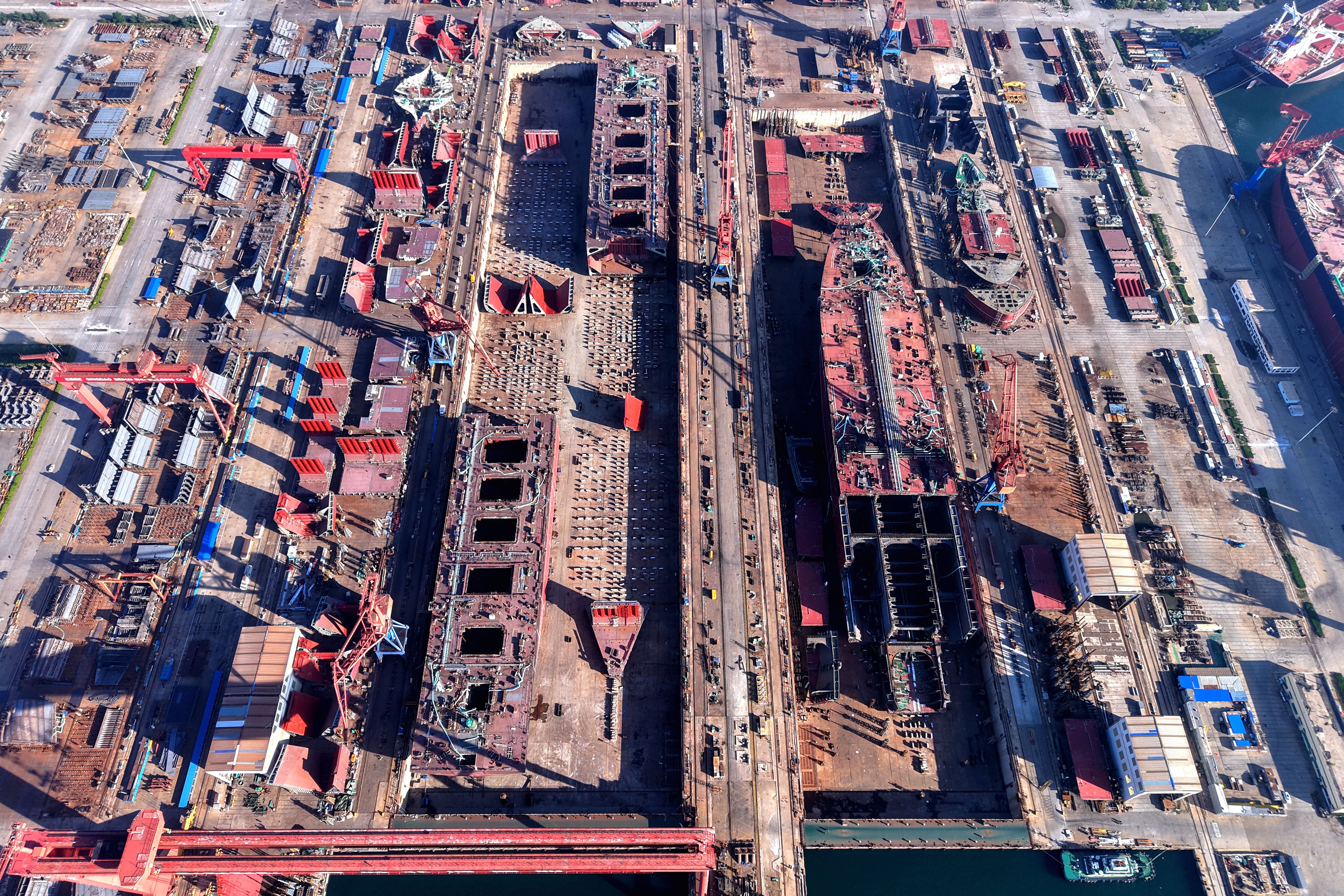
CFOTO/CFOTO/Future Publishing via Getty Images
A Chinese state-owned shipbuilding group was already the world’s biggest. Now it’s finishing up a merger with its main domestic rival, resulting in an absolute juggernaut of an industry force.
China has been quantitatively dominating the global shipbuilding game, leaving the US and its allies playing catch-up. The merger only tightens Beijing’s grip on the industry, handing China a critical advantage in generating commercial and naval power.
Last week, trading in the shares of China State Shipbuilding Corporation (CSSC) and China Shipbuilding Industry Corporation (CSIC) was suspended as CSSC moves to absorb CSIC, which is ultimately being delisted. CSSC previously received approval from the Shanghai Stock Exchange to absorb its competitor in a substantial share-swap deal.
It marked the latest step in a merger that’s been in the works since 2019, a move that will create a new streamlined shipbuilding behemoth. Though the companies merged years ago, industrial overlap continues to be an issue, as is unresolved internal industry competition.
The mega merger cuts duplicated costs and redundant functions for more efficient, more coordinated operations. Post merger, Chinese media reports, CSSC will control some $56 billion in assets while generating $18 billion in annual revenue. Some estimates are higher.

China News Service/China News Service via Getty Images
CSSC is China’s — and the world’s — largest shipbuilding group. It built more commercial vessels by tonnage in 2024 than the entire US shipbuilding industry has built since the end of the World War II, according to a report on Chinese shipbuilding earlier this year from the Center for Strategic and International Studies, a Washington-based think tank.
And CSIC was the country’s second-largest. Both are state-owned, meaning their operations and developments are overseen by the government, and they were originally part of the same firm until split in 1999 under Chinese Communist Party reforms.
The reunion between the two is expected to result in a bigger, more powerful CSSC. It signals China’s push for a more consolidated approach to its commercial and military shipbuilding.
“When it’s all said and done, CSSC will be the largest listed shipbuilding company in the world by a considerable margin, in terms of both assets and revenue,” Matthew Funaiole, a CSIS senior fellow with the China Power Project, told Business Insider. “And maybe more importantly, it will have the full backing of the Chinese state and its industrial policy might.”
That kind of state backing means global rivals face not just a company, but an arm of Beijing’s industrial strategy.
A massive shipbuilding empire

NurPhoto/NurPhoto via Getty Images
CSSC alone is a commercial shipbuilding giant, boasting expansive shipyards, factories, and research institutes controlled by political and military leaders in Beijing.
It includes 84 subsidiaries and employs over 200,000 people across shipbuilding, engineering, research and development, and other areas, CSIS said earlier this year. Comparatively, the entire US shipbuilding industry directly employs just over 100,000 people, per available data.
When the companies first began the merger process, CSSC and CSIC oversaw, by some estimates, $120 billion in combined assets — almost four times as much as South Korean rival Hyundai Heavy Industries. The companies shared resources, including financing, technologies, and personnel.
The merger itself is part of China’s long-standing push to consolidate its shipbuilding, as the “central government is trying to reduce horizontal competition between companies within its domestic market in order to be better positioned to extend its dominance over global markets,” Funaiole said.
And while the number of active Chinese shipyards has decreased since peaking in 2009 at just over 300 — as of 2024, it was around 150 spread across a handful of major production sites — the total production has continued to increase, substantially so in 2023 and 2024. China produced over 50% of global commercial shipbuilding in 2024, well beyond Japan and South Korea. And at its major shipbuilding hubs, especially in Shanghai, Guangzhou, and Dalian, commercial vessels are pumped out at rapid rates.

CFOTO/CFOTO/Future Publishing via Getty Images
Similarly, CSSC and CSIC have thrived on foreign ship orders. Data reviewed by CSIS has shown that foreign firms have purchased hundreds of hulls from China’s biggest yards, resulting in billions in revenue.
Many of these yards are co-production for military shipbuilding, too. CSSC in particular has been a successful case of what Beijing has called its “military-civil fusion” strategy, which removes the barriers between its commercial and defense sectors, allowing one to fuel the other.
China’s dual-use approach has allowed its shipbuilding industry to quickly produce naval vessels using the same equipment and personnel it uses for commercial ones, which has resulted in a naval force buildup that has received increased attention from the US and its allies and partners.
The Chinese People’s Liberation Army’s Navy is the largest in the world, the Pentagon has noted repeatedly in its more recent annual reports on China’s military.
China’s navy maintains a battle force of over 370 ships and submarines. And because China can produce a wide range of ships, engines, weapons, and systems, it is “nearly self-sufficient for all shipbuilding needs,” the most recent report said. Self-sufficiency is an essential capability in a serious conflict, when supply lines could face unexpected pressures.
Challenges for the US and its allies and partners

NurPhoto/NurPhoto via Getty Images
The finalization of this merger adds to long-standing concerns in the West about China’s shipbuilding dominance and raises questions about what the US and its allies, specifically South Korea and Japan, can and will do to bolster their own industries.
US President Donald Trump has made revitalizing American shipbuilding a top priority, and there’s growing talk about having the US military and defense contractors work more closely with South Korean and Japanese companies. Rhetoric, however, has been somewhat out of sync with action.
By combining CSSC and CSIC, China appears to be notably strengthening its domestic industry for continued dominance of global shipbuilding.
In January 2025, China held around 62% of the global order book for merchant vessels through 2033, CSIS reports, with over 80% of orders for new container ships and 30% for LNG, or liquefied natural gas, carriers vital for global trade.
The new CSSC will now have even more resources across its yards for building military vessels.
The consolidation between CSSC and CSIC lends to further expansion of China’s shipbuilding capabilities and capacity, especially as Beijing will have more centralized control that will make it easier to transfer technologies, personnel, and assets for building ships across divisions, Funaiole said.
For Washington and its allies, the merger underscores how far ahead Beijing already is — and the difficulties in catching up.
The post A shipbuilding behemoth is rising in China. By scale, nothing else comes close. appeared first on Business Insider.




